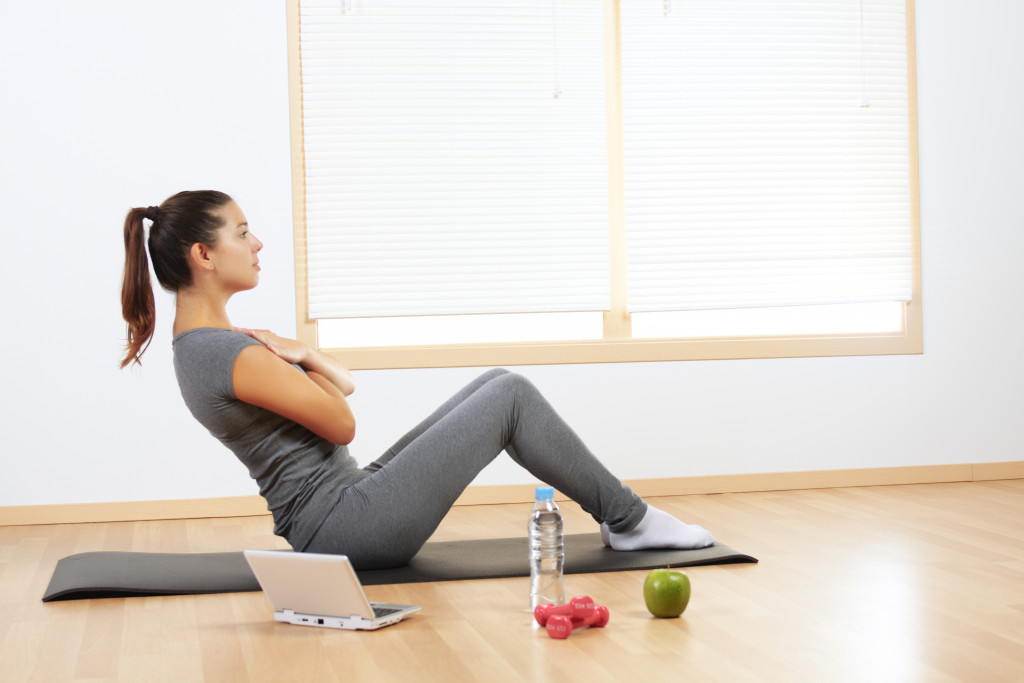Despite the popularity of gyms, yoga classes, and other wellness facilities, many people still prefer to exercise at home — and alone. Not only is it free, but also because they’re away from prying eyes and judgment. Even though no one probably judges others at the gym, it can feel like the opposite, especially for beginners.
Of course, there’s a catch in working out alone at home: You’re not guided by a personal trainer. The closest thing to it is signing up for a paid workout program. But if you’re really adamant about exercising alone, the lack of a personal trainer isn’t an issue to you anyway. Rather, the issue is the risk of your roommates or family members barging into the room while you’re amid a HIIT workout.
That’s a concern many people starting a fitness journey share. When you scan the comments on any workout video on YouTube, you’d always see someone worrying about being seen by whoever they’re living with. The YouTubers listened and uploaded videos without jumping or with no-jumping alternatives for those very people.
If you don’t mind jumping but would still appreciate a nice, quiet workout time, here’s what you can do to ensure that:
1. Communicate Your Need for Alone Time
If you’re living with a roommate you barely speak to until the pandemic, tell them honestly that you’d need 15 to 30 minutes to yourself during your workout days. There’s no harm in letting them know that you’d feel uncomfortable doing squats and burpees with them in the room. In fact, your honesty may allow you to create a schedule that’ll give both of you your space.
For example, if you’d work out from 9:30 AM to 10 AM, maybe that’s your roommate’s schedule for an online class. They’d be holed up in the bedroom while you sweat it off in the living room. The only time they might see you is if they go down to the kitchen to get a drink, which won’t likely happen every day.
2. Use Your Own Bedroom

Using your own bedroom will guarantee the most privacy. However, since some bedrooms don’t have enough space, many people are forced to use the living room instead. But if your living room is always occupied, work with what you have in your bedroom. Clear out as much floor space as you can, and choose workout videos without big movements like skater hops or jump ropes. Focus on exercises you can do within the four corners of your mat.
3. Set Up a Workable Schedule
Beginners typically need two to three days of cardio and two days of strength training. That’s four to five days of working out all in all. If you can fit that schedule in four or five consecutive days, do it on weekdays. That way, your roommates or family members are most likely busy at work. They won’t walk in you randomly.
4. Do Quiet Body Movements
Jumping and jogging make noise. If your roommates or family members aren’t aware that you’re exercising, they might think you’re in danger with all the thudding noises coming from your room. If you haven’t told them yet about your fitness goals, or you work out at night, do silent exercises. Yoga is a good example of such, and so are planks, lunges, and squats.
5. Invest in Exercise Equipment

If you live in a spacious house and have a big room for yourself, consider investing in exercise equipment like a stationary bike, elliptical bike, or treadmill. Those machines will allow you to perform big movements without making noise.
6. Cushion Your Floors
Your feet hitting hardwood floors after a jump will no doubt make noise that can startle your family or roommates, or disturb them while they’re working. To avoid complaints or someone checking in on you, the best solution is to cushion the floors.
For rented spaces, try rubber gym flooring tiles. They’re similar to the interlocking rubber floors you see in children’s playpens. As such, you can install them only when you need them, then disassemble them afterward. Large exercise mats are also a good option, but they might be heavier (lifting them will tone your muscles, though).
If you live in your own home, consider changing the flooring of your exercise space into a high-quality Westex carpet or something alike. Carpet is a popular flooring material in home gyms, with its soft surface that prevents equipment from leaving scratches on the floor. They also absorb sound, so that your jumps and jogs won’t be as audible from the rest of the house. You may still need an exercise mat for movements where you need to lie on your back, though. Letting your sweat soak the carpet may affect its quality.
With these workout hacks, you can exercise at peace and focus on your goals. One day, you’ll just surprise your family or roommate with your fit, sculpted, and strong body.

